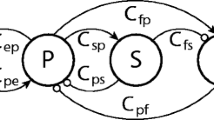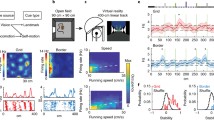Abstract
Neurons are electrically active structures determined by the evolution of ion-specific pumps and channels that allow the transfer of charges under the influence of electric fields and concentration gradients. Extensive studies of spike timing of neurons and the relationship to learning exist. However, the properties of spatial activations during action potential in the context of learning have to our knowledge not been consistently studied. We examined spatial propagation of electrical signal for many consecutive spikes using recorded information from tetrodes in freely behaving rats before and during rewarded T-maze learning tasks. Analyzing spatial spike propagation in expert medium spiny neurons with the charge movement model we show that electrical flow has directionality which becomes organized with behavioral learning. This implies that neurons within a network may behave as “weak learners” attending to preferred spatial directions in the probably approximately correct sense. Importantly, the organization of spatial electrical activity within the neuronal network could be interpreted as representing a change in spatial activation of neuronal ensemble termed “strong learning.” Together, the subtle yet critical modulations of electrical flow directivity during weak and strong learning represent the dynamics of what happens in the neuronal network during acquisition of a behavioral task.
Similar content being viewed by others
References
Aiello G.L., Bach-y-Rita P. (2000): The cost of an action potential. Journal of Neuroscience Methods 103(2): 145–149
Apicella P. (2002): Tonically active neurons in the primate striatum and their role in the processing of information about motivationally relevant events. European Journal Neuroscience 16(11): 2017–2026
Atukorale A.S., Downs T., Suganthan P.N. (2003): Boosting the HONG network. Neurocomputing 51, 75–86
Aur D., Connolly C.I., Jog M.S. (2005): Computing spike directivity with tetrodes. Journal of Neuroscience Methods 149(1): 57–63
Aur D., Connolly C.I., Jog M.S. (2006): Computing information in neuronal spikes. Neural Processing Letters 23, 183–199
Aur D., Jog M.S. (2006): Building spike representation in tetrodes. Journal of Neuroscience Methods 157(2): 364–373
Barnes, T. D., Kubota, Y., Hu, D., Jin, D. Z. and Graybiel, A. M.: Activity of striatal neurons reflects dynamic encoding and recoding of procedural memories, Nature 437(7062) (2005), 1158–1161.
Beierlein M., Gibson J.R., Connors B.W. (2000): A network of electrically coupled interneurons drives synchronized inhibition in neocortex. Nature Neuroscience 3, 904–910
Bokil H., Laaris N., Blinder K., Ennis M., Keller A. (2001): Ephaptic interactions in the mammalian olfactory system. The Journal of Neuroscience 21(173): 1–5
Bowman A.W., Azzalini A. (1997). Applied smoothing techniques for data analysis. oxford statistical science series, 18. Clarendon Press, Oxford, UK
Connolly I.C., Burns B.J., Jog M.S. (2000): A dynamical-systems model for Parkinson’s disease. Biological Cybernetics 83, 47–59
Freund, Y., and Schapire, R. E.: A decision-theoretic generalization of on-line learning and an application to boosting. In: Proceedings of the Second European Conference on Computational Learning Theory, Barcelona, Spain (1995).
Galarreta M., Hestrin S. (1999): A network of fast-spiking cells in the neocortex connected by electrical synapses. Nature 402, 72–75
Gerfen, C. R., and Wilson, C. J.: The basal ganglia. In: L. W. Swanson, A. Bjorklund and T. Hokfelt Handbook of Chemical Neuroanatomy Volume 12: Integrated Systems of the CNS, Part IIII, 371–468, Elsevier, London, (1996).
Gerstner W., Kistler W.M. (2002).: Spiking Neuron Models Single Neurons, Populations, Plasticity. Cambridge University Press, Cambridge
Golding N.L., Kath W.L., Spruston N. (2001): Dichotomy of action-potential backpropagation in CA1 pyramidal neuron dendrites. Journal of Neurophysiology 86, 2998–3010
Gray C.M., Maldonado P.E., Wilson M., McNaughton B. (1995): Tetrodes markedly improve the reliability and yield of multiple single-unit isolation from multi-unit recordings in cat striate cortex. Journal of Neuroscience Methods 63, 43–54
Grossberg S. (1987): Competitive learning: from interactive activation to adaptive resonance. Cognitive Science 11, 23–63
Häusser M., Spruston N., Stuart G.J. (2000): Diversity and dynamics of dendritic signaling. Science 290, 739–744
Hebb D. (1949). The Organisation of Behaviour. Wiley, New York
Holt G.R., Koch C. (1999): Interactions via the extracellular potential near cell bodies. Journal of Computational Neuroscience 6, 169–184
Hormuzdi S.G., Pais I., LeBeau F.E.N., Towers S.K., Rozov A., Buhl E.H., Whittington M.A., Monyer H. (2001): Impaired electrical signaling disrupts gamma frequency oscillations in connexin 36-deficient mice. Neuron 31, 487–495
Jog M.S., Connolly C.I. Kubota Y., Iyengar D.R., Garrido L., Harlan R., Graybiel A.M. (2002): Tetrode technology: advances in implantable hardware, neuroimaging, and data analysis techniques. Journal of Neuroscience Methods 117, 141–152
Jog M.S., Kubota Y., Connolly C.I., Hillegaart V., Graybiel A.M. (1999): Building neural representations of habits. Science 286, 1745–1749
Kasuga A., Enoki R., Hashimoto Y., Akiyama H., Kawamura Y., Inoue M., Kudo Y., Miyakawa H. (2003): Optical detection of dendritic spike initiation in hippocampal CA1 pyramidal neurons. Neuroscience 118, 899–907
Kerr J.N.D., Plenz D. (2002): Dendritic calcium encodes striatal neuron output during up-States. Journal of Neuroscience 22, 1499 – 1512
Kimura M., Matsumoto N., Okahashi K., Ueda Y., Satoh T. (2003): Goal-directed, serial and synchronous activation of neurons in the primate striatum. Neuroreport 14(6): 799–802
Kita H., Kosaka T., Heizmann C.W. (1990): Parvalbumin-immunoreactive neurons in the rat neostriatum: a light and electron microscopic study. Brain Research 536, 1–15
Kohonen T. (2001). Self-Organizing Maps. Springer Verlag, Berlin
Koos T., Tepper J.M. (1999): Inhibitory control of neostriatal projection neurons by GABAergic interneurons. Nature of Neuroscience 2, 467–472
Landisman C.E., Long M.A., Beierlein M., Deans M.R., Paul D.L., Connors B.W. (2002): Electrical synapses in the thalamic reticular nucleus. Journal of Neuroscience 22, 1002–1009
Maass W. (1997): Networks of spiking neurons: the third generation of neural network models. Neural Networks 10, 1659–1671
von der Malsburg C. (1973): Self-organization of orientation sensitive cells in the striate cortex. Kybernetik 14, 85–100
Nolan M.F., Malleret G., Dudman J.T., Buhl D.L., Santoro B., Gibbs E., Buzsaki G., Siegelbaum S.A., Kandel E.R., Morozov A.A. (2004) Behavioral role for dendritic integration: HCN1 channels constrain spatial memory and plasticity at inputs to distal dendrites of CA1 pyramidal neurons. Cell 119, 719–732
Oesch N., Euler T., Taylor W.R. (2005) Direction-selective dendritic action potentials in rabbit retina. Neuron 47(5): 739–750
Quirk M.C., Wilson M.A. (1999), Interaction between spike waveform classification and temporal sequence detection. Journal of Neuroscience Methods 94(1): 41–52
Quirk M.C., Blum K.I., Wilson M.A. (2001), Experience-eependent changes in extracellular spike amplitude may reflect regulation of dendritic action potential back-propagation in rat hippocampal pyramidal cells. The Journal of Neuroscience 21(1): 240–248
Rusu, S., Muljono, H., Cherkauer, B.: Itanium 2 processor 6M: higher frequency and larger L3 cache, IEEE Micro, 2004, ieeexplore.ieee.org.
Schapire R.E. (1990), The strength of weak learnability. Machine Learning 5: 197–227
Schapire, R E., Singer, Y., and Singhal, A.: Boosting and Rocchio Applied to text filtering, SIGIR ’98, Proceedings of the Twenty-first Annual International ACM SIGIR Conference on Research and Development in Information Retrieval, (1998), pp. 215–223.
Shannon, C. E., and Weaver, W.: The mathematical theory of communication. University of Illinois Press, IL (ISBN 0252725484)(1963).
Schmitzer-Torbert N., Jackson J., Henze D., Harris K., Redish A.D. (2005), measures of unit quality for use in extracellular recordings. Neuroscience 131(1): 1–11
Stewart G.W. (1993) The early history of the SVD. SIAM Review 35, 558–561
Valiant L.G. (1984), A theory of the learnable. Communications of the ACM 27: 1134–1142
Verzi, S. J., Heileman, G. L., Georgiopoulos, M., and Healy, M. J.: Boosted ARTMAP in neural networks proceedings, IEEE world congress on computational intelligence. The 1998 IEEE International Joint Conference Anchorage, Ak, USA, 1 (1998), 4–9.
Wilson M.A., McNaughton B.L. (1993) Dynamics of the hippocampal ensemble code for space. Science 261: 1055–1058
Author information
Authors and Affiliations
Corresponding author
Rights and permissions
About this article
Cite this article
Aur, D., Jog, M.S. Neuronal spatial learning. Neural Process Lett 25, 31–47 (2007). https://doi.org/10.1007/s11063-006-9029-2
Received:
Accepted:
Published:
Issue Date:
DOI: https://doi.org/10.1007/s11063-006-9029-2




